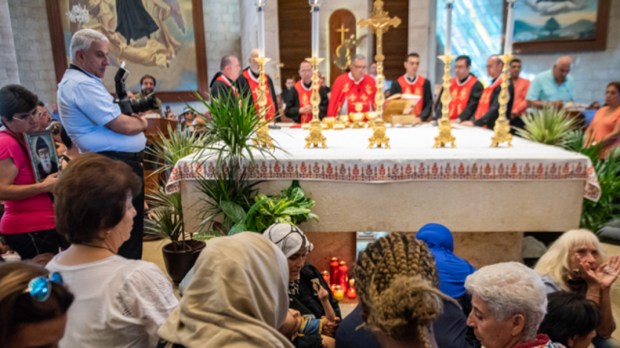Pope Francis recently expressed deep concern for Lebanon, and set September 4 as an international day of prayer and fasting for the country. It was not the first time a pope took such great interest in the Near Eastern country.
Near the end of the 15-year civil war in Lebanon, in 1989, Pope John Paul II issued an Apostolic Letter on the Situation in Lebanon to all the bishops of the Catholic Church. In the text he warned that “without doubt, the disappearance of Lebanon would be one of the world’s greatest sorrows,” and said that saving Lebanon is “one of the most urgent and most noble tasks that the contemporary world must take upon itself.”
In 1995, five years after the end of the civil war, John Paul called for a Special Assembly for Lebanon of the Synod of Bishops, which took place in Vatican City. It recommended that the various Catholic Churches in Lebanon work together more effectively, develop closer ecumenical relations with other Churches not in full communion with Rome, and foster a spirit cooperation and mutual respect with Lebanese of other religions, according to Paulist Fr. Ronald G. Roberson, associate director of the Secretariat of Ecumenical and Interreligious Affairs of the United States Conference of Catholic Bishops.
According to the CIA’s World Factbook, Lebanon’s religious makeup, based on a 2018 estimate, is as follows:
- Muslim: 61.1% (30.6% Sunni, 30.5% Shia, smaller percentages of Alawites and Ismailis)
- Christian: 33.7% (Maronite Catholics are the largest Christian group)
- Druze: 5.2%
- Very small numbers of Jews, Baha’is, Buddhists, and Hindus
No other country in the Middle East-North Africa region has as large a proportion of Christians.
Maronites are the largest Christian denomination in Lebanon. Due to emigration over the years, there are significant numbers of Maronites in North and South America and in Australia. Yet they are not so well known by most Christians in the West, even by Roman Catholics.
According to Fr. Roberson, writing in The Eastern Christian Churches: A Brief Survey, the Maronites trace their origin to the late-4th century, when a monastery was founded around the charismatic figure of the monk St. Maron. By the 8th century, the monks “moved with their band of followers into the remote mountains of Lebanon, where they existed in relative isolation for centuries.”
Because of the Crusades, the Maronites came into contact with the Latin Church in the 12th century. In 1182 the entire Maronite nation formally confirmed its union with Rome.
“There is a strong tradition among the Maronites that their Church never lacked communion with the Holy See,” Roberson wrote.
In the 16th century, the Ottomans took over the Maronite homeland, but by the 19th century the Western powers, especially France, “began to offer protection to the Maronites within the Ottoman Empire,” Roberson wrote. “A massacre of thousands of Maronites in 1860 provoked the French to intervene with military forces. After World War I both Lebanon and Syria came under French control.”
Fr. Roberson continued:
When France granted Lebanon full independence in 1943, it attempted to guarantee the safety of the Maronite community by drawing boundaries that would ensure a permanent Maronite majority, and leaving behind a constitution guaranteeing, among other things, that the president would always be a Maronite. This arrangement was threatened by the 15-year long civil war that erupted in Lebanon in 1975. Soon Christians were no longer a majority in the country since many thousands of Maronites left the country to make new lives for themselves in the West, and the very existence of Lebanon seemed uncertain.
In 2003, a three-year Maronite Patriarchal Assembly began, seeking to, among other goals, rediscover Maronite heritage and traditions and promote the renewal of ecclesial life.
Today there are 10 dioceses in Lebanon, where the patriarch resides, with over 800 parishes, and seven other jurisdictions in the Middle East. Official Vatican statistics indicate that there were 1,413,652 Maronites in Lebanon at the end of 2006.
In the United States, there are two Maronite eparchies, or dioceses, one based in Brooklyn, New York, the other in St. Louis. These consist of 60 or so parishes.
Western Christians visiting a Maronite church may be surprised by the style of the religious service. The Maronite liturgy is of West Syrian origin, but it has been influenced by the East Syrian and Latin traditions, Fr. Roberson explained: “The Eucharist is essentially a variation of the Syriac liturgy of St. James. Originally celebrated in Syriac, the liturgy has been for the most part in Arabic since the Arab invasions.”

